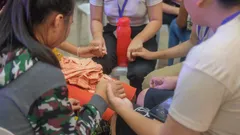
Modern parenting can be a bit of a surprise—especially when those little hands start to grab gadgets. The pressure of putting boundaries on time spent in front of screens and balancing work with play and family life is a reality. With digital devices now part of our daily routines, being able to help children develop healthy use of their devices is more crucial than ever. Here’s why finding the perfect balance is crucial—and how one famous couple’s story could help you plan your next family relocation.
Why Healthy Gadget Use Matters
The majority of Filipino households depend upon smartphones and tablets for education and entertainment. Recent studies show that 8 out of 10 families have devices shared among household members. However, too much screen time—especially for children under 12 years old—can negatively impact the quality of sleep and development. According to doctors, cutting down on the use of gadgets helps children develop the ability to communicate, encourages physical exercise, and enhances concentration. Small changes, like establishing timetables, can result in huge benefits over the long haul.
How Dennis Trillo and Jennylyn Mercado Set Digital Boundaries

Celebrity parents Dennis Trillo and Jennylyn Mercado face the same challenges as any other parent. At home, they follow simple rules—no electronics during meals and screen time is mostly for educational reasons. Jennylyn shares that she reserves weekends to bond with family members without technology, ensuring that time together is of high quality. Their routine is relatable, teaching responsibility and setting an example in a digital world.
It’s not about removing devices. It’s about guiding children to use them responsibly—even if that requires reminding yourself, too.
Practical Checklist for Digital Parenting
- Designate gadget-free areas like bedrooms and dining tables.
- Set a regular screen time limit. The American Academy of Pediatrics suggests no more than 1 hour of screen time per day for children ages 2–5.
- Encourage alternative activities, such as drawing, biking, or reading.
- Use technology to help teach digital literacy and security.
- Talk regularly about online content and encourage open communication.
Adapting to a Tech-Savvy Generation
Today’s children are digitally savvy. The challenge isn’t only about keeping them from technology but preparing them to navigate the digital world responsibly. In the Philippines, where parks for children are common and neighborhood homes are regular play spots, a balanced schedule lets children play offline as much as online. This boosts confidence, creativity, and social skills—key for their future.
Setting these boundaries isn’t always easy. Sometimes, there are arguments or discussions at home, especially when homework and YouTube or games clash. However, sticking to family rules—like Trillo and Mercado—helps build trust and discipline over time.
Finding the Right Mix for Every Family
Each family’s experience is unique, and what works for one may not suit another. Some parents use reward systems to motivate their children to limit screen time, while others swap gadgets for more time outdoors.
Parents and their children can draw inspiration from local stars while considering their own values, schedules, and support systems. At the core of digital parenting is the goal to raise responsible, healthy children in a tech-driven world.
For families mastering technology use and learning parenting strategies that fit Filipino lifestyles, blending the right behavior with consistency makes all the difference. Setting mindful limits now leads to more meaningful moments in the future. If you’re figuring out the right amount of screens for your kids, remember—a balanced approach is always in style.
Speaking from my own circle, juggling parenting and gadgets can feel like walking a tightrope on a sunny afternoon in Makati. There are days when kids ask for more YouTube and my heart gives in. But I’ve also seen how sticking to a device plan—just like Dennis Trillo and Jennylyn Mercado—keeps our whole family focused on fun and making lasting memories. In reality, finding the sweet spot between family bonding and healthy screen time can make all the difference.
 Meg Magazine
Meg Magazine















Comments